Zwieback Substitutes
Top Alternatives for Your Recipes
Zwieback toast is a simple, crunchy biscuit often enjoyed for its delicate sweetness and firm texture, commonly served with tea or coffee and used as a teething aid for infants. Originating from Germany, the name "zwieback" means "twice baked," which perfectly describes its baking process. First, a sweetened bread is baked, and then sliced and baked again until it achieves its characteristic dry, crisp texture. While zwieback is a cherished snack, it can sometimes be hard to find in stores, prompting the need for suitable substitutes.
When zwieback toast is unavailable, several alternatives can fulfill the role without compromising on flavor or texture. Some substitute options are readily available in the pantry, such as melba toast or breadcrumbs. Others can be made at home with common baking ingredients like flour, milk, sugar, and butter. These replacements are not just functional but can also add a new dimension to dishes, allowing for culinary creativity. Homemade substitutions can be tailored to dietary preferences or adjusted for flavor with the addition of spices such as cinnamon or nutmeg.
Understanding Zwieback
Zwieback is a type of crisp, sweetened bread, known for its unique twice-baked process. It traditionally incorporates simple ingredients such as flour, yeast, and sugar, which contribute to its distinctive texture and flavor.
History of Zwieback
Zwieback, which translates from German as "twice-baked," has a rich history dating back to at least the 17th century. Initially, it was created as a way to preserve bread. By baking bread a second time, it would dry out and could be stored for longer periods. This made zwieback a popular food among travelers and sailors.
Ingredients and Preparation
The basic components of zwieback include:
Flour: Often white flour is used for a light texture.
Yeast: This is essential for the bread to rise.
Milk: Adds richness to the dough.
Eggs: Provide structure and color.
Butter: Contributes to the crumb's tenderness.
Sugar: For a touch of sweetness.
Salt: To enhance flavor.
The preparation of zwieback toast involves mixing these ingredients to form a dough, which is then allowed to rise. The dough is shaped into logs or slices, and baked once to create bread. After cooling, the bread is sliced and baked again until it becomes dry and crispy.
Uses of Zwieback
Zwieback is often enjoyed as a snack or as an accompaniment to beverages like tea or coffee due to its crunchy texture. It is also suitable for infants transitioning to solid food, as it is easy to digest and can soothe teething pain. Historically, brands like Nabisco offered zwieback toasts which were widely available and popular among consumers.
Zwieback in Diets and Health
Zwieback toast, a crispy, lightly sweetened bread, has traditionally been used as a food for teething babies and as a digestible option for those with sensitive stomachs. Its role in diets, however, can vary based on dietary restrictions and health goals.
Zwieback for Babies
Teething babies often find relief in gnawing on a piece of Zwieback toast due to its hard texture, which makes it an excellent tool for soothing sore gums. It's easily digestible, which makes it a preferred choice for parents introducing their baby to solid foods. The toast softens upon contact with saliva, reducing the risk of choking and facilitating a gradual transition to more solid foods.
Dietary Considerations
When considering dietary preferences and restrictions for adults, some may seek alternatives to Zwieback due to its gluten content, which can be troublesome for those with gluten intolerance or celiac disease. For individuals on special diets such as keto, Zwieback is typically not suitable due to its high carbohydrate content. For those looking for a healthier option, it's important to find substitutes that provide similar textural benefits without compromising their dietary goals. In these cases, homemade recipes using alternative flours or commercial gluten-free Zwieback can be considered.
Homemade Zwieback Substitutes
When making homemade zwieback toast, one can create a simple replica or include additional flavors to enhance the traditional teething biscuit. The base recipe requires common baking ingredients and kitchen tools, such as a baking sheet and parchment paper for easy handling.
Basic Zwieback Substitute Recipe
One begins the homemade zwieback toast recipe by mixing the key dry ingredients:
1 cup of whole wheat flour
2 teaspoons of baking powder
1/2 teaspoon of salt
1 tablespoon of granulated sugar
Then, the baker adds in:
3 tablespoons of cold, unsalted butter (cut into cubes)
The mixture should be combined until it is crumbly, taking care not to overmix. The dough is then shaped and baked until dry and crisp, resembling traditional zwieback toast.
Variations with Spices and Nuts
To add a twist to the standard zwieback, one can introduce various spices and nuts:
For a hint of warmth, one-fourth teaspoon of ground cinnamon and nutmeg can be folded into the dough.
Chopped nuts of choice can also be incorporated for added texture and flavor.
After the initial bake, the baker may sprinkle cinnamon sugar over the slices before the second bake for a sweet and spiced crust.
Each variation brings its unique qualities to the zwieback substitute, allowing one to customize the recipe according to personal preferences or dietary needs while maintaining the biscuit's signature crispness.
Store-Bought Alternatives
When looking for Zwieback toast substitutes, consumers have convenient options available on grocery store shelves that maintain the desired texture and flavor profile for recipes or snacking.
Comparison of Commercial Substitutes
Italian Biscotti: Biscotti serves as a close substitute, providing a similar crispiness and subtle sweetness.
Rusk: Often used interchangeably with Zwieback, rusk is a dry, twice-baked bread that provides a comparable texture and taste.
Melba Toast and Panko Breadcrumbs: For recipes that require a crispy element, plain Melba toast or crunchy panko breadcrumbs can be used as a substitute to mimic the consistency expected from Zwieback.
Substitute Texture Flavor Profile Best Used For Italian Biscotti Crisp, Dense Sweet Snacking, Desserts Rusk Dry, Crispy Mild, Slightly Sweet Teething, Snacking Melba Toast Light, Crunchy Neutral Toppings, Snacking Panko Breadcrumbs Light, Airy Neutral Baking, Cooking
Using Biscuits and Crackers
Biscuits and crackers can be selected strategically when Zwieback is unavailable. Biscuits that are plain and less flaky can emulate Zwieback's firmness and are suitable particularly in baking applications. Crackers, on the other hand, can range from salty to sweet and should be chosen based on the recipe requirements.
Alternative Type Texture Flavor Profile Considerations Biscuits Firm, less flaky Varied, often plain Choose plain varieties Crackers Ranges from soft to crisp Varied, from salty to sweet Match to recipe's flavor needs
When utilizing these alternatives, it is important to consider the desired outcome of the recipe to ensure a successful substitution.
Adapting Traditional Recipes
In the realm of cooking, adapting recipes to suit personal tastes or ingredient availability is a customary practice. When it comes to traditional dishes like those requiring zwieback, bakers can either recreate the original recipe at home or infuse new life into classics with modern ingredients and techniques.
Baking Zwieback at Home
For those who prefer to stick closely to traditional recipes but can't find zwieback readily available, one can bake it at home with a few basic ingredients. A typical homemade zwieback recipe might include milk, sugar, unsalted butter, flour, yeast, along with a pinch of cinnamon and nutmeg. The process involves warming the milk, activating the yeast, and then combining these with the melted butter, eggs, and other ingredients.
Ingredients:
1/2 cup of milk
1/4 teaspoon each of cinnamon and nutmeg
1 cup of melted unsalted butter
3 eggs
Instructions:
Warm the milk and dissolve the yeast to activate.
Add the butter, eggs, spices, and flour to form a dough.
Bake until golden and then slice and toast the slices again to achieve dry, crunchy zwieback.
Modern Twists on Classic Zwieback
The original zwieback toast, known for its dry, crispy texture, often finds its place crushed as zwieback crumbs in various recipes. Modern adaptations might use substitutions such as crushed plain melba toast or panko breadcrumbs. These substitutes can provide a similar texture and structural integrity to dishes like cheesecakes or as a crispy topping.
In infusing a twist on the classic, cooks might experiment with the addition of various cheeses or spices to the dough, providing an additional flavor profile that complements the recipe at hand. Baking powder can be employed for a lighter texture, and adjustments to baking times can yield zwieback that aligns with contemporary palates and health considerations.
Creative Uses of Zwieback Substitutes
Zwieback substitutes offer culinary flexibility, functioning well in a range of sweet and savory dishes. They provide both texture and a neutral flavor base that can be tailored to each recipe.
Sweet Applications
In sweet dishes, Zwieback substitutes like melba toast can be transformed into a cinnamon toast variant. How to create:
Cinnamon Sugar Topping: Mix equal parts of sugar and cinnamon, sprinkle over buttered melba toast slices, and broil until caramelized.
For dessert purposes, Zwieback substitutes serve as an excellent base for toppings or as components in recipes. Sweet dessert uses:
Crunchy Layer in Parfaits: Crumble the substitute and layer with sweetened cream and fruit.
Binding Agent in Cakes: Replace crushed Zwieback in recipes that require a firmer texture.
Savory Pairings
Substitutes are not only for sweet treats; they can be coupled with savory items as well. Craft savory dishes:
Breadcrumbs for Meat: Ground melba toast offers a crispy coating for chicken or fish.
Crunchy Additions to Salads: Toasted and seasoned breadcrumbs can add a delightful crunch to a fresh salad.
Table: Savory Combination Ideas
Substitute Application Complementary Flavors Melba Toast Breadcrumbs Herbs, Garlic, Parmesan Panko Top Layer Cheese, Chive, Bacon
Utilizing a Zwieback substitute does not detract from the authenticity of these creative culinary endeavors, it rather provides a versatile tool to enhance both staple recipes and innovative creations.
Frequently Asked Questions
When using or preserving substitutes for Zwieback toast, it’s important to know the suitable alternatives and the best ways to keep them fresh. Here's what cooks need to know when addressing common concerns in the kitchen.
Substituting for Zwieback in Recipes
Q: What can be used in place of Zwieback toast in recipes?
A: For those who cannot find Zwieback, here are practical alternatives:
Crushed Melba Toast: A fine substitute, especially for recipes needing a dry, crispy texture.
Crunchy Panko Breadcrumbs: Offers a similar crispness and is excellent for adding a delicate crunch.
When using these substitutes, one should consider the texture and flavor profile of the food they're preparing, as it may slightly alter the original intended results of the recipe.
Storing and Preserving Substitutes
Q: How should substitutes for Zwieback be stored to maintain freshness?
A: Proper storage extends the shelf life of Zwieback substitutes.
Melba Toast: Store in an airtight container, away from moisture, to prevent it from becoming stale.
Panko Breadcrumbs: Keep in a cool, dry place; if the original packaging is opened, transfer to a resealable bag or container.
One must also be aware that different cooking questions may require specific storage solutions, particularly for ensuring that the substitutes remain as similar as possible to the texture and dryness of Zwieback when used in recipes.
Cultural Significance of Zwieback
Zwieback toast holds a notable place across varied cultures, reflecting its role in culinary traditions and festive occasions.
Zwieback in World Cuisines
The humble zwieback has crossed borders, becoming an integral part of various world cuisines. In Finland, korpu is the equivalent of zwieback, often enjoyed with coffee or tea. Michigan's Upper Peninsula, influenced by Finnish immigrants, has its own version referred to as Trenary Toast, a cinnamon-flavored zwieback. This toast has gained popularity for its crispy texture and is often dipped in beverages. Furthermore, Dame Nellie Melba, an Australian opera singer, inspired the creation of Melba toast, a lighter variant resembling zwieback characteristics, leading to its inclusion in diverse culinary traditions.
Holiday Traditions
During holiday seasons, zwieback takes center stage in certain traditions. One particular example is the Christmas Tea Ring found in European and North American celebrations, where zwieback provides structure and texture to this festive bread. Renowned baking companies like King Arthur Flour provide recipes for these types of bread, emphasizing the importance of a dry, durable zwieback-like base that withstands the rich decorations and flavors typically associated with holiday pastries.
Conclusion
In the quest for appropriate Zwieback toast substitutes, Melba toast and panko breadcrumbs have emerged as readily available and practical options. Both of them offer a similar texture and can be easily integrated into recipes that call for a crunchy component. For homemade alternatives, a simple recipe combines basic ingredients such as milk, sugar, butter, flour, yeast, and spices like cinnamon and nutmeg.
Those who prefer whole wheat variations can consider a recipe that incorporates whole wheat flour, baking powder, salt, sugar, and cold unsalted butter. This homemade approach allows for customization according to dietary preferences or specific tastes.
When considering a substitute for Zwieback toast, it is essential to match the texture and flavor profile as closely as possible. For dishes requiring a sweet, crispy element, a homemade version crafted with cinnamon and nutmeg can provide a similar essence. On the other hand, Melba toast or panko breadcrumbs could be more suitable for savory dishes due to their neutral taste and crunchy texture.
Irrespective of the choice made:
Melba toast works well as a base for canapés, as a topping for casseroles, or as a breadcrumb substitute.
Panko breadcrumbs offer a desirable crunch, particularly for breading in fried foods.
Homemade Zwieback can be tailored to taste preferences, offering a rewarding project for those inclined to bake.
Selecting a substitute for Zwieback is ultimately about finding a balance between texture, flavor, and the intended use in a recipe, ensuring that meals retain their character even in the absence of the original ingredient.










